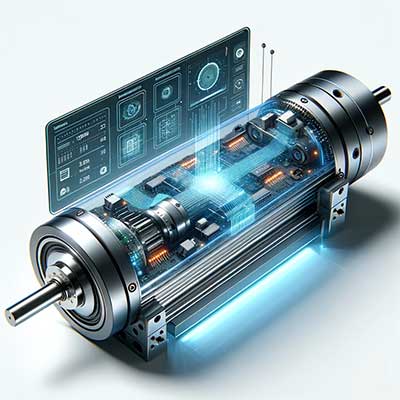The global industrial and automation landscape is undergoing rapid transformation, and among the many technologies enabling this shift, linear motors have emerged as vital components for motion control and precision engineering. The linear motor market is witnessing significant growth, driven by its widespread applications across industries such as robotics, semiconductor manufacturing, electronics, automotive, and packaging.
A linear motor is an electric motor that produces motion in a straight line rather than rotational motion. Unlike traditional motors, which require mechanical conversions to achieve linear motion, linear motors offer a direct-drive solution, resulting in higher efficiency, better accuracy, and reduced mechanical wear. As industries seek to improve performance, reduce maintenance, and increase production speed, the demand for linear motors has surged globally.

What is a Linear Motor and Why Is It Important?
Linear motors operate on the same electromagnetic principles as rotary motors, but their unrolled structure allows for direct linear movement. The two main types of linear motors are:
-
Flat Linear Motors: Used for high-precision applications with long strokes and large forces.
-
U-Channel or Tubular Linear Motors: Ideal for compact applications and high dynamic performance.
The linear motor market is gaining traction due to several inherent advantages of these motors:
-
High precision and accuracy
-
High-speed operation
-
Maintenance-free design (no gears or belts)
-
Compact and efficient for tight spaces
Key Market Drivers
1. Surge in Automation and Industry 4.0
As factories worldwide adopt smart manufacturing practices, linear motors are increasingly favored for their ability to provide precise and responsive motion control. The linear motor market is seeing strong growth in sectors such as electronics, food & beverage, and packaging where high-speed and high-accuracy tasks are essential.
2. Growth in Semiconductor and Electronics Industry
Semiconductor manufacturing requires ultra-precise positioning and cleanroom-compatible components. Linear motors are widely used in wafer inspection systems, lithography machines, and chip packaging equipment. The rise of the electronics industry directly contributes to the expansion of the linear motor market.
3. Adoption in Robotics and Medical Equipment
Modern robotic systems use linear motors for their agility and reduced maintenance. In the medical sector, linear motors support surgical robots, diagnostic equipment, and automated laboratory instruments where smooth and precise linear motion is critical.
4. Rising Demand for Energy-Efficient Solutions
Linear motors eliminate the need for intermediate mechanical parts, which reduces energy loss and increases overall system efficiency. As energy conservation becomes a priority, the linear motor market benefits from its sustainable and efficient technology.
5. Technological Advancements
Continuous R&D has led to innovations such as ironless linear motors, which offer reduced cogging and superior motion smoothness. Integration with advanced control systems and feedback devices has made linear motors more adaptive and intelligent, widening their scope in modern applications.
Market Segmentation and Regional Outlook
The linear motor market can be segmented by type, application, and region:
-
By Type: Cylindrical, flat-plate, and U-shaped linear motors
-
By Application: Semiconductor equipment, robotics, machine tools, material handling, and others
-
By Region: North America, Europe, Asia-Pacific, Latin America, Middle East & Africa
Asia-Pacific leads the global linear motor market, fueled by large-scale manufacturing in China, Japan, and South Korea. The region’s robust electronics and automotive sectors are major contributors. North America follows closely, with a high rate of automation adoption in manufacturing and logistics. Europe also presents promising growth, particularly in Germany and Italy, where industrial automation is deeply embedded in the manufacturing culture.
Challenges Facing the Linear Motor Market
While the outlook for the linear motor market is largely positive, several challenges need to be addressed:
-
High Initial Cost: Compared to traditional motors, linear motors can be expensive to purchase and install, potentially limiting adoption in cost-sensitive industries.
-
Complex Integration: Proper alignment and precision installation are necessary, and retrofitting existing machinery can be complicated.
-
Thermal Management Issues: High-performance linear motors can generate significant heat, requiring sophisticated cooling systems in some applications.
-
Competition from Alternative Technologies: Servo motors and pneumatic actuators still dominate many automation tasks due to their cost and familiarity.
Future Outlook and Opportunities
The future of the linear motor market looks promising, particularly as digitalization and automation continue to advance. Emerging trends that are expected to shape the future include:
-
Integration with IoT and AI: Smart factories will require intelligent motion control systems that can communicate and adapt in real time. Linear motors equipped with sensors and AI algorithms will be key.
-
Expansion into New Industries: Beyond traditional manufacturing, linear motors are finding applications in agriculture automation, electric vehicles, and renewable energy systems.
-
Miniaturization for Portable Devices: As precision motion becomes necessary in smaller devices, miniaturized linear motors will gain popularity.
-
Synergies with Data-Driven Solutions: Similar to how sectors like the cyber insurance market are evolving to address risks in digital operations, the linear motor market is benefiting from predictive maintenance and data analysis capabilities to ensure system uptime and performance.
Conclusion
The linear motor market is on a robust growth trajectory, driven by the increasing demand for efficient, precise, and maintenance-free motion control solutions. With its critical role in automation, robotics, and high-tech manufacturing, the market is well-positioned to capitalize on global trends toward digital transformation and intelligent production.
Despite challenges related to cost and complexity, technological advancements and expanding application areas will continue to propel the market forward. As industries evolve, the linear motor market will remain a cornerstone of innovation and industrial efficiency.
Related Trending Reports
| Gaming Accessories Market |
| Fire Protection System Market |
| Sports Technology Market |
| Smart Building Market |
| Smart TV Market |
Comments on “The Future of Motion Control Lies in the Linear Motor Market”